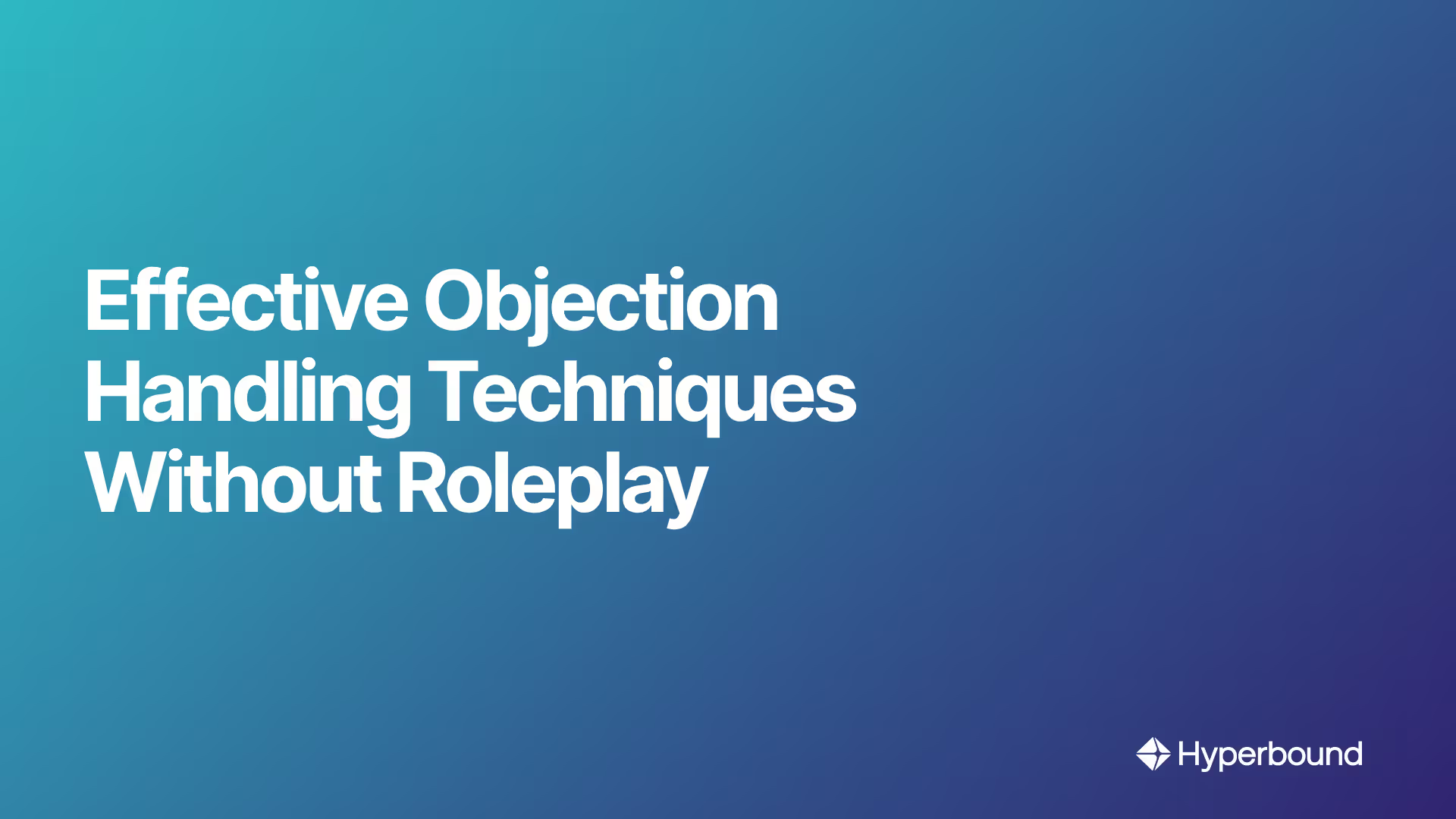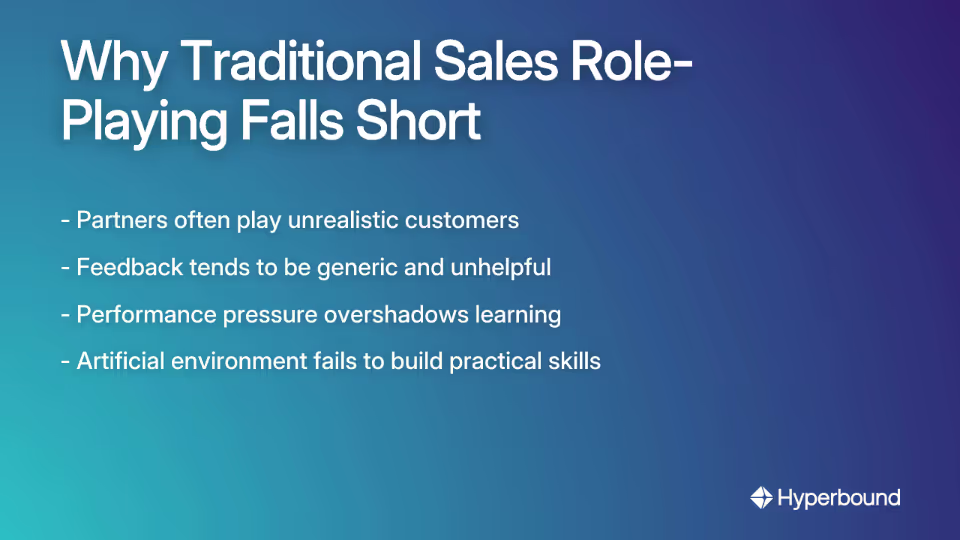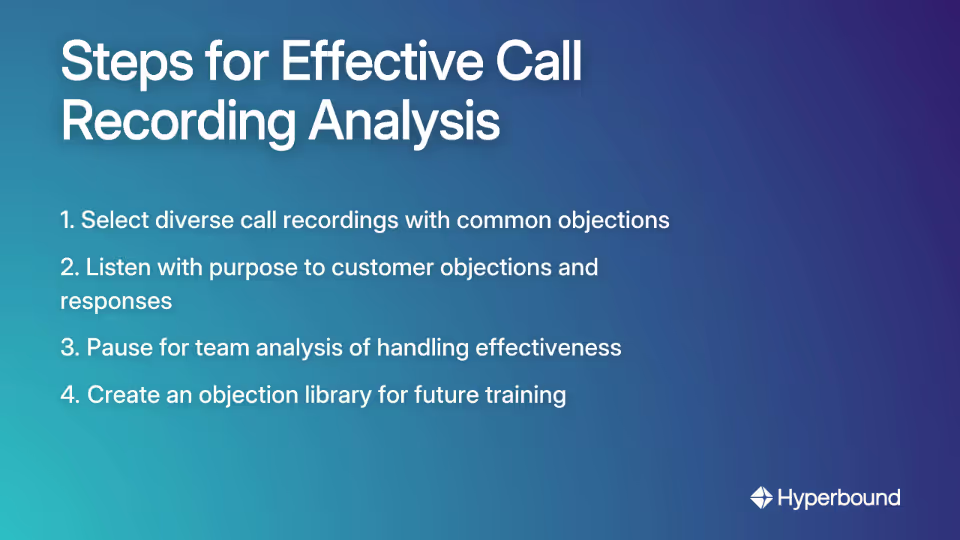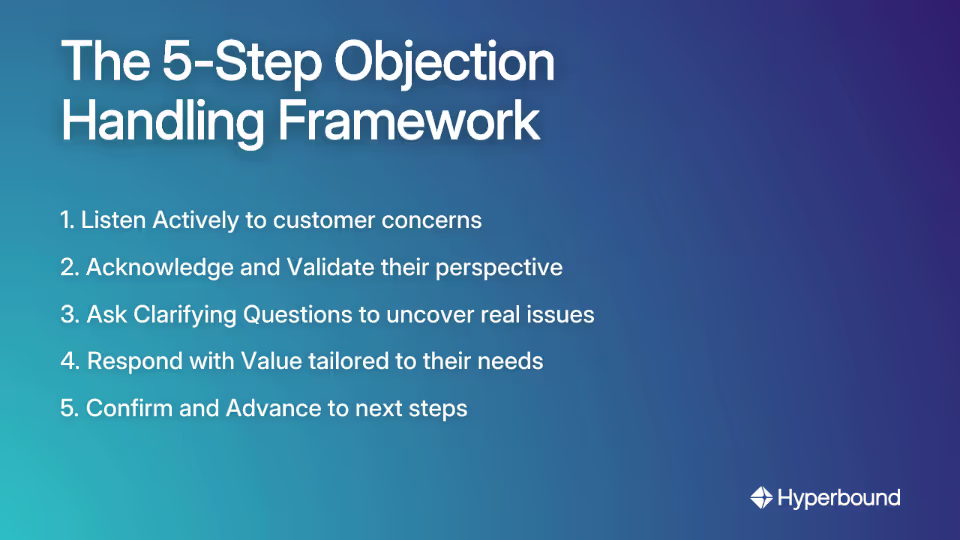
You've been there. The awkward silence. The forced smiles. The strange feeling of pretending to be someone else while your colleague fumbles through a scripted sales pitch. Traditional role-playing in sales training often feels more like bad community theater than professional development.
"It always feels like everyone is just trying to memorize their lines and not embarrass themselves," reports one sales professional. Another bluntly states, "I think it's childish. We are grown."
Yet the ability to handle objections effectively remains one of the most critical skills in your sales arsenal. When objections are handled satisfactorily, a sales rep's success rate can jump as high as 64%, according to industry research.
So how do you build this high-value skill without subjecting your team to the cringe-worthy mock call scenarios that make everyone uncomfortable? This guide will walk you through three powerful, practical alternatives that build real skill without the theatrical awkwardness.
Why Traditional Role-Play Fails (And Why It Matters)
The fundamental issue with traditional sales training role-play is that it can't recreate the complexity of real customer interactions. As one sales professional put it, "You can't recreate a live customer meeting because there's so many factors that go into how a conversation goes."
In typical role-playing scenarios:
- Partners often play unrealistic "closed off, quiet, no opinion" customers
- Feedback tends to be generic and unhelpful
- The pressure to perform overshadows actual learning
- The artificial environment fails to build practical skills

But the goal isn't just to avoid embarrassment—it's to develop the confidence and competence to transform objections from roadblocks into opportunities for deeper engagement.
Method 1: The 'Film Review' — Analyze Real Call Recordings
The most recommended alternative to role-playing comes straight from top-performing sales teams: analyzing real call recordings. This approach replaces artificial scenarios with actual customer interactions, helping reps develop their own natural cadence.
"Listen to call recordings and give feedback," suggests one sales professional who finds traditional role-play "awkward and not productive."
How to Run an Effective Film Review Session:
- Select a Range of Calls: Choose recordings that feature common objections, including both successful and unsuccessful handling. Look for examples of price objections, timing concerns, and competitive comparisons.
- Listen with Purpose: As a team, listen to the moment when an objection arises. Pay special attention to:
- The customer's exact wording and tone
- The salesperson's immediate response
- The customer's reaction to that response
- How the conversation progressed afterward
- Pause for Analysis: After hearing the objection and response, pause the recording and ask:
- What was the real concern behind the stated objection?
- How effectively did the salesperson acknowledge and address it?
- What verbal cues indicated the customer's satisfaction level?
- What alternative approaches might have worked better?
- Create an Objection Library: Document effective responses and organize them by objection type. This becomes a valuable resource for training and reference.

This method provides the authenticity missing from scripted scenarios while creating a safe environment for learning. Platforms like Hyperbound can automate this entire process, using AI to analyze thousands of calls, identify key moments, and score them against your playbook. Best of all, it leverages real customer language and situations that your team actually encounters.
Method 2: Collaborative Brainstorming — Tap Your Team's Collective Genius
Rather than putting individuals on the spot with mock call scenarios, collaborative brainstorming sessions harness diverse perspectives to solve common objections. This approach aligns with what sales professionals actually value: "Not roleplaying as in pretending to be a caller and a client, but throwing out ideas for campaigns, scripts, presentations I think is important for preparation."
Powerful Brainstorming Techniques for Objection Handling:
- Round-Robin Objection Response: The facilitator presents a common objection (e.g., "Your solution is twice the price of your competitor"). Each team member contributes one possible response in turn, with no criticism allowed until all ideas are collected. This ensures everyone participates regardless of seniority or confidence level.
- Brainwriting: This nonverbal method reduces performance anxiety. Provide sticky notes and have everyone silently write 3-5 responses to a specific objection. The notes are passed around the group, with each member building on the original ideas. This technique prevents the "anchoring effect" where the first idea dominates the conversation.
- Objection Mapping: Place a common objection in the center of a whiteboard (physical or virtual). Branch out with potential underlying causes, follow-up questions, and different response strategies, visually connecting related ideas. This technique, popular for its visual and collaborative nature, provides a structural framework for addressing complex objections.
The collaborative approach offers several advantages over traditional role-play:
- It removes the spotlight from individuals, reducing anxiety
- It generates a wider range of potential responses
- It builds team cohesion and shared knowledge
- It creates a repository of tested responses for common situations
After the brainstorming session, document the best responses for each objection type and share them with the team for future reference. This becomes a living document that evolves as your team encounters new objections and develops better responses.

Method 3: Targeted Drills — Build Muscle Memory with Round-Robin Responses
Sometimes, the challenge with objection handling isn't knowing what to say—it's being able to say it confidently and naturally in the moment. Targeted drills help build that muscle memory without the pressure of a full mock call.
"Role-playing should emphasize refining messaging and addressing common objections to enhance sales performance," notes one sales professional.
How to Run Effective Objection Response Drills:
- Prepare a List of Common Objections: Gather the most frequent objections your team encounters from your customer persona research. These might include:
- "We don't have budget for this right now."
- "We're already using a competitor."
- "This isn't a priority for us."
- "I need to discuss this with my team/boss."
- Set the Stage: Explain that this is a rapid-response drill, not a performance. The goal is to practice different response approaches quickly and build mental agility.
- Conduct the Drill: The facilitator calls out an objection, and team members take turns giving a one or two-sentence immediate response. Encourage variety:
- A clarifying question
- An empathy statement
- A value-based reframe
- A social proof example
- Quick Feedback Round: After everyone has responded, briefly discuss which approaches felt most effective and why. This creates a feedback session that's constructive rather than critical.
- Repeat with Variations: Change the objections or add context that makes them more challenging. For example: "We don't have budget for this... and we just spent our entire allocation on your competitor's product."
This drill format builds confidence through repetition while keeping the environment supportive and focused on improvement rather than perfection.
Your Objection Handling Toolkit: Proven Frameworks and Techniques
Beyond practice methods, equip your team with a structured approach to handling any objection. Leading sales methodologies emphasize that having a consistent framework helps reps respond confidently even to unexpected objections.
The 5-Step Objection Handling Framework:

- Listen Actively: Let the customer fully express their concern without interruption. Pay attention to both their words and tone to identify the underlying issue.
- Acknowledge and Validate: Show empathy with statements like, "I understand your concern" or "That's a valid point." This builds rapport and shows you're not dismissing their perspective.
- Ask Clarifying Questions: Dig deeper with open-ended questions to understand the real issue. For example, when facing a price objection, ask "Compared to what?" This technique, shared by sales professionals on Reddit, forces a value-based comparison rather than just a price-based one.
- Respond with Value: Address the specific concern by focusing on the value proposition that matters most to this particular customer. Connect your solution directly to their stated business goals.
- Confirm and Advance: Check if your response has addressed their concern, then suggest a clear next step in the sales process.
Tactical Plays for Common Objections:
For Price Objections:
- Ask: "What was your budget for a solution like this?" This helps determine if they're a qualified prospect.
- Use the Boomerang Technique: "The ROI from [specific feature] typically pays for the solution within the first six months, which is why many clients see our price as an investment rather than a cost."
For "We're Happy with Our Current Solution" Objections:
- Use a respectful challenge: "I understand change can be difficult, but if you weren't considering making a change, we probably wouldn't be having this discussion. What aspects of our solution intrigued you enough to take this meeting?"
- Focus on gaps: "Many of our current customers were previously using [competitor]. They found that [specific feature] addressed a challenge they couldn't solve with their previous solution."
For Timing Objections:
- Probe for underlying concerns: "What would need to happen for this to become a priority sooner?"
- Create urgency through opportunity cost: "While waiting, what's the cost to your business of not addressing [specific pain point]?"
Putting It All Together: Your Objection Handling Practice Plan
Mastering objection handling isn't about memorizing scripts or enduring awkward role-play sessions. It's about building a system for continuous, realistic, and collaborative practice.
Here's a weekly practice schedule that combines all three methods:
- Monday Film Review (30 minutes): Analyze one call recording featuring a challenging objection.
- Wednesday Brainstorming (30 minutes): Focus on one common objection and generate multiple response approaches.
- Friday Rapid Response Drill (15 minutes): Practice quick responses to 3-5 different objections.
By following this schedule, your team will gradually build confidence in handling objections without ever having to sit through another uncomfortable scripted scenario.
Remember, the goal isn't to "win" against objections—it's to understand customer concerns and guide the conversation toward mutual value. As you refine your approach through these practice methods, you'll transform objections from anxiety-inducing roadblocks into valuable opportunities to demonstrate your understanding of customer needs.
The most successful sales professionals don't dread objections; they welcome them as a chance to deepen the conversation and build stronger relationships. With these alternative practice methods, your team can develop that same confidence and skill—no awkward role-playing required.
Start implementing these techniques today, and watch as your team's closing rate improves through more effective objection handling. After all, in sales, it's not about avoiding the difficult conversations—it's about mastering them.
Frequently Asked Questions
Why is traditional sales role-play often ineffective?
Traditional sales role-play often fails because it's an artificial environment that doesn't replicate the complexity of real customer conversations. Participants tend to focus on memorizing lines rather than genuine interaction, partners may act as unrealistic customers, and the pressure to perform can overshadow actual learning, making the exercise awkward and unproductive.
What are some effective alternatives to sales role-playing for objection handling?
Three powerful alternatives to traditional role-playing are: analyzing real call recordings (Film Reviews) to learn from actual customer interactions, collaborative brainstorming sessions to tap into the team's collective knowledge without individual pressure, and targeted rapid-response drills to build muscle memory for common objections in a low-stakes environment.
How can analyzing real call recordings improve sales skills?
Analyzing real call recordings provides authentic learning material, replacing artificial scenarios with real customer language, tone, and objections. This method allows teams to dissect what works and what doesn't in a safe, analytical setting, identify the true concerns behind objections, and build a library of proven, effective responses based on actual successful outcomes.
What is a simple framework for handling any sales objection?
A proven 5-step framework for handling sales objections is: 1) Listen actively to the customer's full concern. 2) Acknowledge and validate their point to build rapport. 3) Ask clarifying questions to uncover the real issue. 4) Respond by connecting your solution's value to their specific need. 5) Confirm you've addressed their concern and advance to the next step.
How do you handle the common "your price is too high" objection?
To handle price objections effectively, first seek to understand the context by asking questions like, "Compared to what?" or "What budget did you have in mind for a solution like this?" Then, reframe the conversation from cost to value using the Boomerang Technique, highlighting the return on investment (ROI) and how the solution pays for itself, positioning the price as a strategic investment.
How can I make objection handling practice less awkward for my team?
Make practice less awkward by shifting the focus from individual performance to collaborative problem-solving. Use methods like team-based call reviews, group brainstorming, and rapid-response drills where the emphasis is on generating ideas and quick repetition, not on a flawless performance. This removes the "spotlight" and reduces the performance anxiety that makes traditional role-play uncomfortable.

Book a demo with Hyperbound
.png)













